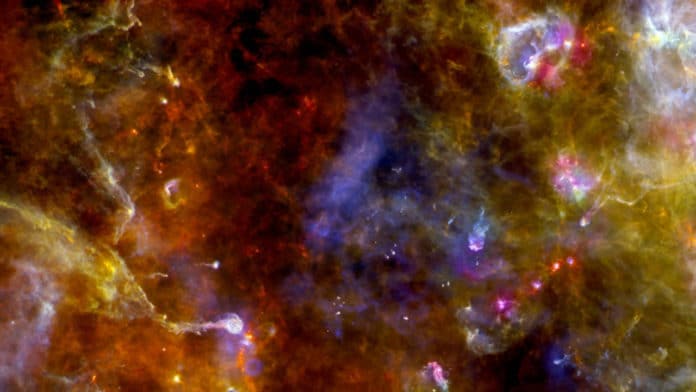In astronomy, the interstellar medium (ISM) is the matter and radiation that exists in the space between the star systems in a galaxy. This matter includes gas in ionic, atomic, and molecular form and dust and cosmic rays. As the dust particles clump together and merge into celestial bodies, stars and planets originated in such an environment.
Important chemical processes also occur on these particles, from which complex organic – possibly even prebiotic – molecules emerge. However, for these processes to be possible, there has to be water.
Specifically, in cold cosmic environments, water occurs in the form of ice. However, the connection between ice and dust in these regions of space was unclear.
A new study by the Friedrich Schiller University Jena and the Max Planck Institute for Astronomy- aimed to compare the mid-infrared spectra of laboratory silicate grain/water ice mixtures with astronomical observations to evaluate the presence of dust/ice mixtures in interstellar and circumstellar environments.
Their study has offered evidence that the dust particles and the ice are mixed.
Scientists compared the spectra of laboratory-made silicates, water ice, and their mixtures with astronomical spectra of protostellar envelopes and protoplanetary disks. They established that the spectra are congruent if silicate dust and water ice are mixed in these environments.
Dr. Alexey Potapov of the University of Jena said, “We need to understand different physical conditions in different astronomical environments, to improve the modeling of physico-chemical processes in space. This result would enable researchers to estimate the amount of material better and to make more accurate statements about the temperatures in different regions of the interstellar and circumstellar media.”
By comparison, scientists observed what happens with water when the temperatures increase. The ice leaves the solid body to which it is bound and passes into the gas phase at about 180 Kelvin (-93 degrees Celsius).
Potapov said, “Some water molecules are so strongly bound to the silicate that they remain on the surface or inside dust particles. We suspect that such ‘trapped water’ also exists on or in dust particles in space. At least that is what is suggested by the comparison between the spectra obtained from the laboratory experiments and those in what is called the diffuse interstellar medium. We found clear indications that trapped water molecules exist there.”
The existence of such solid-state water indicates that there are some complex molecules present in dust particles. If water is present on such particles, it is not a long way to complex organic molecules. This is because the dust particles usually consist of carbon, among other things, which, in combination with water and under the influence of ultraviolet radiation such as that found in the environment, promotes the formation of methanol, for example. Organic compounds have already been observed in these regions of the interstellar medium, but it has not been known where they originated until now.
Potapov said, “The presence of solid-state water can also answer questions about another element: although we know the amount of oxygen in the interstellar medium, we previously had no information about where exactly around a third of it is located. The new research results suggest that the solid-state water in silicates is a hidden reservoir of oxygen.”
The “trapped water” can help understand how the dust accumulates, as it could promote the sticking together of smaller particles to form larger particles. This effect may even work in planet formation.
Potapov said, “If we succeed in proving that ‘trapped water’ existed – or could exist – in building blocks of the Earth, there might even be new answers to the question of how water came to Earth. But as yet, these are only suppositions that the Jena researchers want to pursue in the future.”
Journal Reference:
- Alexey Potapov et al. Dust/ice mixing in cold regions and solid-state water in the diffuse interstellar medium. DOI: 10.1038/s41550-020-01214-x
